
The Genus Fuchsia
Section Hemsleyella
(fifteen species)
The species in Hemsleyella grow in cloud forest or, less commonly, in scrub forest, puna, or subpáramo habitats in the tropical Andes from Venezuela to Bolivia at elevations from 1,100 to 4,200 meters (Berry 1985) and consist of terrestrial or epiphytic shrubs, subshrubs, or lianas, sometimes tuberous, with opposite, ternate, or alternate, usually deciduous, leaves. The axillary, pendant flowers are clustered at the branch apex or in racemes and exhibit an elongated floral tube eighteen to 160 millimeters long in various shades of red to orange-red, pink or lavender. The nectaries are smooth and unlobed. The sepals are shorter than the floral tube, connate at the base, erect to spreading or sometimes recurved, and colored rose-red to green, or dull purple-pink. Petals are absent. Stamens occur in two unequal series with yellow pollen. The seeds number between 50 and 250.
The section is characterized by the great rarity of many of its members, some of which are known from just one or a few collections, and attests to the high degree of local endemism found in the mountains of central Peru.
Hemsleyella was named in honor of the English botanist, William Botting Hemsley (1843-1924), Keeper of the Library and Herbarium at Kew. He had published a paper on "The Apetalous Fuchsias of South America" in the Journal of Botany (14:69-70) in 1875. A version of his name first appeared as Fuchsia hemsleyana (Woodson & Seibert 1937) but that species is now a synonym of Fuchsia microphylla subsp. hemsleyana (Woodson & Seibert, Breedlove 1937) in Fuchsia sect. Encliandra.
Name: Fuchsia sect. Hemsleyella Munz, 1943.
Typus: F. apetala Ruiz & Pav.
Section Hemsleyella
(fifteen species)
The species in Hemsleyella grow in cloud forest or, less commonly, in scrub forest, puna, or subpáramo habitats in the tropical Andes from Venezuela to Bolivia at elevations from 1,100 to 4,200 meters (Berry 1985) and consist of terrestrial or epiphytic shrubs, subshrubs, or lianas, sometimes tuberous, with opposite, ternate, or alternate, usually deciduous, leaves. The axillary, pendant flowers are clustered at the branch apex or in racemes and exhibit an elongated floral tube eighteen to 160 millimeters long in various shades of red to orange-red, pink or lavender. The nectaries are smooth and unlobed. The sepals are shorter than the floral tube, connate at the base, erect to spreading or sometimes recurved, and colored rose-red to green, or dull purple-pink. Petals are absent. Stamens occur in two unequal series with yellow pollen. The seeds number between 50 and 250.
The section is characterized by the great rarity of many of its members, some of which are known from just one or a few collections, and attests to the high degree of local endemism found in the mountains of central Peru.
Hemsleyella was named in honor of the English botanist, William Botting Hemsley (1843-1924), Keeper of the Library and Herbarium at Kew. He had published a paper on "The Apetalous Fuchsias of South America" in the Journal of Botany (14:69-70) in 1875. A version of his name first appeared as Fuchsia hemsleyana (Woodson & Seibert 1937) but that species is now a synonym of Fuchsia microphylla subsp. hemsleyana (Woodson & Seibert, Breedlove 1937) in Fuchsia sect. Encliandra.
Name: Fuchsia sect. Hemsleyella Munz, 1943.
Typus: F. apetala Ruiz & Pav.
F. apetala Ruiz & Pav.
Bolivia and Peru. Found on the eastern slopes of the Peruvian Andes from San Martín Department south to Puno Department and in Bolivia, La Paz and Cochabamba Departments in upper cloud forest and the lower reaches of the Puna, on rocks, tree trunks and sphagnum banks at elevations from (2,800 to) 3,200 to 3,850 (to 4,200) meters but most common above 3,600 meters.
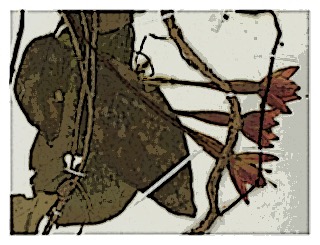 Flowering is principally in the dry season, from June to September.
Flowering is principally in the dry season, from June to September.
Habit—Prostrate to hanging subshrubs in rock crevices or on the edge of banks rich in sphagnum or humus, or vine-like epiphytes on moist tree trunks. Tubers ellipsoid to cylindrical, 2 to 8 cm long and 1 to 5 cm thick, covered by copper-tan, flaking bark, often interconnected by slender stems. Stoloniferous shoots 2 to 12 dm long when epiphytic (lacking when terrestrial), 2 to 4 mm thick with freely exfoliating red-copper bark; leaves and flowers borne on short, lateral, knotty-tortuous stems with tightly packed leaf and pedicel scars, these stems rarely more than 4 cm long, 3 to 8 mm thick, dull gray, pilose to hirsute.
Leaves—Alternate and usually tightly clustered at the branch tips, mostly deciduous at anthesis or present on plants flowering in shady habitats, soft membranous, subcordate to ovate-elliptic, 60 to 120 (to 150) mm long, 35 to 65 mm wide, apex acute to acuminate, base rounded to obtuse or subcordate, densely pilose-hirsute when young, green and subglabrous to strigose above at maturity, slightly paler and pilose below, with appressed, densely villous hairs along veins; margin subentire to denticulate, secondary veins 6 to 8 on either side of the midvein; petiole 25 to 50 (to 70) mm long, 2 to 3.5 mm thick, reddish, pilose; stipules filiform, 2 to 3 mm long, deciduous.
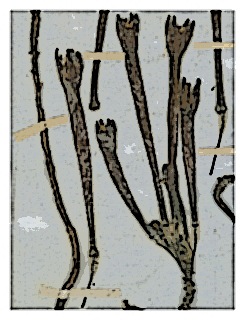 Flowers—Crowded near the tip of lateral, knotty twigs, usually three to twelve per shoot, pedicels pilose to hirsute, (10 to) 18 to 35 mm long, ovary cylindrical, subtetragonous, 6 to 12 mm long, 2 to 4 mm thick, short pilose to densely hirsute, the hairs often shaggy and to 2 mm long, floral tube subcylindrical, 4 to 16 cm long, 3 to 6 mm wide and somewhat nodose at the base around the nectary, then narrowed to 2 to 4 mm wide followed by a gradual widening until 7 to 10 mm wide at the rim, sometimes dilated to 8 to 13 mm wide just below rim, pilose to densely hirsute in the basal 1 to 2 mm, loosely pilose for the rest of length, inside subglabrous to villous 10 to 35 mm above the base, sepals ovate, broadly acute, 16 to 25 (to 30) mm long, 7 to 12 (to 16) mm wide, usually broader than the tube, connate at the base for Ih-1J2 the total length, free segments spreading to slightly recurved at anthesis. Tube rose to light orange-red, at times with a dark purple, nitid ring at the rim, sepals rose red and usually dull yellow-green distally. Nectary lustrous green-purple, lining the basal 5 to 6 mm of the tube, filaments green to dull pink with age, the antesepalous ones 10 to 18 mm long, the antepetalous ones 8 to 15 mm long, anthers narrowly oblong, 3.5 to 4.5 mm long, 1.5 to 2 mm wide, yellow, style pale green, subglabrous to densely (retrorse) villous between 10 to 40 mm above the base, the basal 10 to 15 mm usually glabrous, stigma green, globose-capitate, slightly four-cleft, 2 to 4 mm long, 1.5 to 2.5 mm wide, exserted 1 to 15 mm beyond the anthers.
Flowers—Crowded near the tip of lateral, knotty twigs, usually three to twelve per shoot, pedicels pilose to hirsute, (10 to) 18 to 35 mm long, ovary cylindrical, subtetragonous, 6 to 12 mm long, 2 to 4 mm thick, short pilose to densely hirsute, the hairs often shaggy and to 2 mm long, floral tube subcylindrical, 4 to 16 cm long, 3 to 6 mm wide and somewhat nodose at the base around the nectary, then narrowed to 2 to 4 mm wide followed by a gradual widening until 7 to 10 mm wide at the rim, sometimes dilated to 8 to 13 mm wide just below rim, pilose to densely hirsute in the basal 1 to 2 mm, loosely pilose for the rest of length, inside subglabrous to villous 10 to 35 mm above the base, sepals ovate, broadly acute, 16 to 25 (to 30) mm long, 7 to 12 (to 16) mm wide, usually broader than the tube, connate at the base for Ih-1J2 the total length, free segments spreading to slightly recurved at anthesis. Tube rose to light orange-red, at times with a dark purple, nitid ring at the rim, sepals rose red and usually dull yellow-green distally. Nectary lustrous green-purple, lining the basal 5 to 6 mm of the tube, filaments green to dull pink with age, the antesepalous ones 10 to 18 mm long, the antepetalous ones 8 to 15 mm long, anthers narrowly oblong, 3.5 to 4.5 mm long, 1.5 to 2 mm wide, yellow, style pale green, subglabrous to densely (retrorse) villous between 10 to 40 mm above the base, the basal 10 to 15 mm usually glabrous, stigma green, globose-capitate, slightly four-cleft, 2 to 4 mm long, 1.5 to 2.5 mm wide, exserted 1 to 15 mm beyond the anthers.
Fruit—The berry is oblong, red, subtetragonous, 17 to 25 mm long, 8 to 12 mm thick, subglabrous to densely hirsute, and more or less verrucose.
Seeds: Many-seeded.
Chromosomes—Gametic chromosome number n = 22.
Authors—Ruiz & Pavon 1802.
Original publication—Fl. Peruv. 3: 89 1802.
Synonyms—F. macrantha Hook. 1846; F. hirsuta Hemsl. 1876; F. unduavensis Munz 1943.
Herbarium Specimens—Field Museum 1, Field Museum 2; Kew 1, Kew 2, Kew 3, Kew 4; New York; Smithsonian.
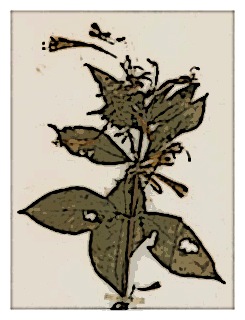 F. cestroides Schulze-Menz
F. cestroides Schulze-Menz
Northwestern Peru. Rare and endemic to scrub vegetation on the Pacific-facing slopes of the Andes in Cajamarca, Lambayeque, and Piura Departments at elevations from 1,100 to 1,700 meters.
Habit—Erect to scandent shrubs one half to three meters tall. Branchlets terete, 1.5 to 3 mm thick, puberulent to pilose; older stems 5 to 40 mm thick, with exfoliating bark.
Leaves—Opposite or ternate, membranous, elliptic, 26 to 100 mm long, 14 to 15 mm wide, apex and base acute, subglabrous to puberulent above, puberulent below, especially on the veins; margin subentire to serrulate, secondary veins 6 to 14 on either side of the midvein. Petioles strigose, (2 to) 48 mm long. Stipules lanceolate, about 1 mm long, about 0.5 mm wide.
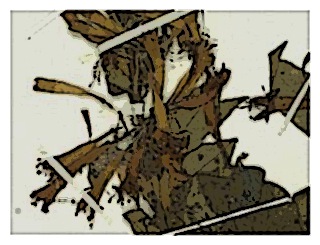
Flowers—Generally numerous on terminal and axillary racemes with. small, deciduous, lance-filiform bracts, rachis (15 to) 25 to 35 mm long, pedicels puberulent, 3 to 4 mm long, Ovary cylindrical, 3 to 4 mm long, 1 to 1.5 mm wide, puberulent to pilose, floral tube narrowly funnelform, 18 to 20 mm long, 2 to 3 mm wide at the base, narrowed to about 1.5 mm wide in the lower 113, then gradually widened to about 4 mm wide at the rim, lightly puberulent to pilose outside, retrorse villous inside in lower 113, sepals oblonglanceolate, 5 to 7 mm long, 2.5 to 3 mm wide, obtuse to acute at the apex, connate for about 1.5 mm at the base, spreading at anthesis. Tube rose pink to lavender, sepals greenish (in bud) to dull purple. Nectary about 3 mm high, filaments green, the antesepalous ones 3.5 to 6 (to 7) mm long, the antepetalous ones 2 to 5 mm long, anthers broadly elliptic, yellow,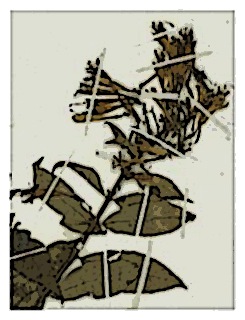 about 1.5 mm long, about 1mm wide, style glabrous, exserted 5 to 8 mm beyond the anthers, stigma clavate, 1.5 to 2 mm long, about 1 mm wide, slightly four-cleft at the apex.
about 1.5 mm long, about 1mm wide, style glabrous, exserted 5 to 8 mm beyond the anthers, stigma clavate, 1.5 to 2 mm long, about 1 mm wide, slightly four-cleft at the apex.
Fruit—The immature berry is oblong, 8 mm long and 5 mm wide.
Seeds: About 50 per berry
Chromosomes—Gametic chromosome number n = 11.
Authors—Schulze-Menz 1940.
Original publication—Notizbl. Bot. Gart. Berlin-Dahlem 15: 137 1940.
Synonyms—None.
Herbarium Specimens—Field Museum; California Academy; Smithsonian.
F. chloroloba I.M.Johnst.
Southern Peru. Endemic to cloud forest in several valleys in Provo Paucartambo and Provo Quispicanchis Departments, Cuzco at elevations from (1,600 to) 2,200 to 2,800 meters.

Flowers appear in the dry season, principally from May to October.
Habit—Shrubs one to two meters high, usually growing in rocks or epiphytic on trees, with globose to ellipsoid tubers 1 to 4 cm thick. Branchlets terete, smooth, purplish, 1.5 to 5 mm thick; older stems 0.5 to 2 meters long, 5 to 18 mm thick, with freely exfoliating bark.
Leaves—Alternate, usually lacking at anthesis, membranous, narrowly lance-ovate, 60 to 120 mm long, 20 to 55 (to 60) mm wide, apex acuminate, base cordate to subcordate, glabrous on both sides; margin subentire to remotely denticulate, secondary veins 5 to 9 on either side of the midvein. Petioles 14 to 45 mm long. Stipules filiform, about 2 mm long, 0.2 to 0.3 mm wide, deciduous.
Flowers—Few to numerous, axillary or clustered at the tips of young shoots, pedicels dull red or green, 26 to 60 (to 70) mm long, ovary (narrowly) cylindric, 10 to 24 mm long, 2 to 4 mm wide, lustrous light green, floral tube (38 to) 41 to 51 mm long, 4 to 5 mm wide and bulbous at the base, thereupon strongly constricted to 1.5 to 2 mm wide in the lower third to quarter of the tube, then abruptly widened until 10 to 13.5 mm wide in the upper half before narrowing slightly to 9 to 11 (to 12) mm wide at the rim, glabrous outside, pilose inside in the lower quarter. Sepals lance-ovate, thin membranous, 16 to 24 mm long, 5 to 10 (to 12) mm wide, apex acute to acuminate, connate for 5 to 7 mm at the base, tetragonous in bud, spreading-divergent at anthesis. Tube glaucous, bright scarlet to light orange-pink, sepals parrot green. Nectary 6 to 8 mm high, filaments green, the antesepalous ones 10 to 16 mm long, the antepetalous ones 8 to 13 mm long, anthers oblong, yellow, 4 to 5 mm long, 2 to 3 mm wide, style pale green, pilose inside in the lower third, stigma clavate, green, 4 to 4.5 mm long, about 2 mm wide, exserted 5 to 15 mm beyond the anthers.
long, the antepetalous ones 8 to 13 mm long, anthers oblong, yellow, 4 to 5 mm long, 2 to 3 mm wide, style pale green, pilose inside in the lower third, stigma clavate, green, 4 to 4.5 mm long, about 2 mm wide, exserted 5 to 15 mm beyond the anthers.
Fruit—Unknown. The mature berry not described.
Seeds—Unknown.
Chromosomes—Gametic chromosome number n = 11.
Authors—Johnston 1939.
Original publication—J. Arnold Arbor. 20: 243 1939.
Synonyms—F. tuberosa.
Herbarium Specimens—Field Museum 1, Field Museum 2.
F. garleppiana Kuntze & Wittm.
Bolivia. Endemic to cloud forest in Cochabamba Department at elevations from 2,500 to 2,950 meters.
Flowers appear principally in the dry season, when the plant leafless, from March/April to August.
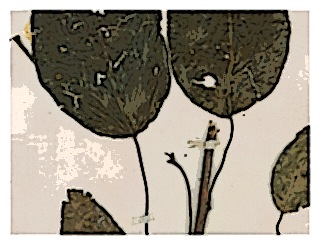
Habit—Shrubs one half to four meters tall, growing epiphytically or more commonly out of rock crevices, with strongly developed cylindrical tubers 10 to 80 cm long and 2 to 4 cm thick and more or less erect branches one to two and one half meters long. Young growth densely white-pilose; branchlets terete, 2 to 4 mm thick, red-green; older stems 4 to 10 mm thick, with freely exfoliating bark.
Leaves—Alternate, usually absent at anthesis, membranous, ovate to ellipticovate, mature blades 90 to 130 mm long, 55 to 75 mm wide, apex subacuminate, base rounded to cordate, light green and subglabrous above, pilose along veins and margin below; margin subentire to remotely denticulate, secondary veins 9 to 10 on either side of the midvein. Petioles pilose, 40 to 73 mm long on mature leaves. Stipules filiform, about 2 mm long, deciduous.
Flowers—Few to many, axillary or grouped at branch tips, pedicels densely pilose, greenish pink, 7 to 30 (to 60) mm long, ovary narrowly cylindric, 7 to 8 mm long, 2 to 2.5 mm thick, densely pilose, floral tube narrowly tubular-funnelform, (45 to) 70 to 140 mm long, 3.5 to 6 (to 7) mm wide and bulbous at the base, then constricted to 2 to 2.5 mm wide and gradually widened above until 7 to 10 mm wide below the slightly constricted mouth, pilose outside, villous inside for most of length, sepals lance-ovate, 10 to 18 mm long, 5.5 to 7 (to 8) mm wide, apex acute, connate for about third of length at the base, spreading divergent at anthesis. Tube and sepals light to very pale pink, with a dark purple ring on the throat where the stamens are inserted. Nectary lustrous green-purple, 4 to 6 mm high, filaments green, the antesepalous ones 10 to 12 mm long, the antepetalous ones 8 to 9 mm long, anthers yellow, 3 to 4 mm long, 1.5 to 2 mm wide, style light pink, villous for most of the length, stigma green, globose, 2 to 2.5 mm long, 2.5 to 3 mm wide.

Fruit—The young berries narrowly cylindric, about 22 mm long and about 4 mm wide.
Seeds—Unknown.
Chromosomes—Gametic chromosome number n = 11.
Authors—Kuntze & Wittmack 1893.
Original publication—Gartenflora 42: 461 1893.
Synonyms—None.
Herbarium Specimens—New York 1, New York 2.
F. huanucoensis P.E.Berry
Central Peru. Known only from the type locality in cloud forest at the Carpish Divide in Huánuco Department at elevations from 2,750 to 2,950 meters.
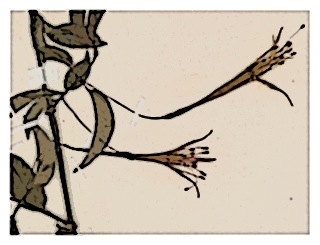
Flowering period unrecorded: Known to be in flower from October to November.
Habit—Low, scandent shrubs with oppositely branched stems. Branchlets subterete, 1 to 3 mm thick, purplish, pilose with white hairs; older branches pilose, with lustrous purple bark splitting longitudinally.
Leaves—Present at anthesis, opposite, firmly membranous, narrowly ellipticovate, 40 to 80 mm long, 18 to 30 mm wide, apex subacuminate, base acute to rounded, apparently dark green and subglabrous above, paler below with pilose midvein and margin; margin subentire, secondary veins 6 to 10 on either side of the midvein. Petioles strigose, purplish, 6 to 10 mm long. Stipules lance-triangular, 1 to 1.5 mm long, deciduous.
Flowers—Few and axillary, close to the branch tips, pedicels slender, drooping, sparsely pilose, 24 to 35 mm long, ovary oblong, 6 to 7 mm long, about 3 mm wide, floral tube narrowly funnelform, 31 to 34 mm long, about 3.5 mm wide at the base, then gradually widened above until about 7 mm wide at the rim, subglabrous outside, pilose inside in lower Ih, sepals narrowly lanceolate, apex narrowly acute to acuminate, 22 to 23 mm long, 4 to 5 mm wide, connate for 2 to 3 mm at the base, tips strongly spreading or recurved at anthesis. Tube and sepals magenta or bright reddish pink. Nectary about 3 mm high, filaments reddish, the antesepalous ones 13 to 20 mm long, the antepetalous ones 9 to 14 mm long, anthers narrowly oblong, 3 to 4 mm long, about 2 mm wide, style reddish, pilose for most of length, stigma subclavate, barely four-cleft at the apex, about 2 mm long, about 1.5 mm wide.
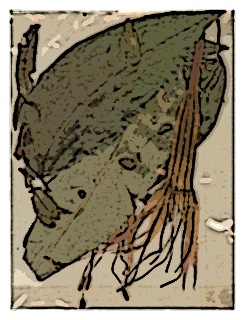
Fruit—Unknown.
Seeds—Unknown.
Chromosomes—Gametic chromosome number unknown.
Authors—Berry 1985.
Original publication—Ann. Missouri Bot. Gard. 72: 235 1985.
Synonyms—None.
Herbarium Specimens—Kew 1, Kew 2.
F. inflata Schulze-Menz
Cuzco Department, Peru. Endemic to several valleys on the eastern slopes of the Andes at elevations from (2,350 to) 2,850 to 3,000 meters.
Flowering period is principally in the dry season, from June to August.
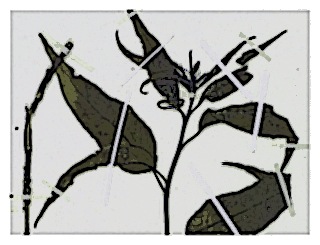 Habit—Shrubs one to three meters high, usually growing among rocks, or epiphytic on trees, with well-developed, cylindrical, tan tubers 2 to 50 cm long and 2 to 4 cm thick. Branchlets terete, 2 to 5 mm thick, tan to reddish, glabrous to densely cinereous or velutinous; older stems erect to divergent and 1 to 3 meters long, 4 to 12 mm thick, with freely exfoliating bark.
Habit—Shrubs one to three meters high, usually growing among rocks, or epiphytic on trees, with well-developed, cylindrical, tan tubers 2 to 50 cm long and 2 to 4 cm thick. Branchlets terete, 2 to 5 mm thick, tan to reddish, glabrous to densely cinereous or velutinous; older stems erect to divergent and 1 to 3 meters long, 4 to 12 mm thick, with freely exfoliating bark.
Leaves—Alternate or rarely opposite, membranous, narrowly elliptic to ovate, 55 to 135 mm long, 20 to 52 mm wide, apex acuminate, base acute to rounded or subcordate, glabrous to sparsely pubescent above, glabrous to pubescent along the veins below; margin subentire to remotely denticulate, secondary veins 6 to 9 on either side of the midvein. Petioles glabrous to canescent-velutinous, 12 to 22 (to 35) mm long. Stipules filiform, 1.5 to 2 mm long, deciduous.
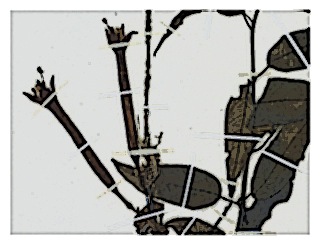 Flowers—axillary, one or few to numerous, usually densely clustered at branch tips, pedicels pale green to reddish, 20 to 55 (to 70) mm long, glabrous to densely pubescent, ovary ellipsoid to narrowly cylindrical, 8 to 18 mm long, 2 to 3 mm wide, subglabrous to densely cinereous, sometimes 8-sulcate, floral tube 85120 mm long, 5 to 9 mm wide and strongly bulbous at the base, strongly constricted to 2 to 4 mm wide above the nectary, then abruptly widened to (8 to) 10 to 14 mm wide in the upper part of the tube, slightly constricted to 7 to 12 mm wide at the mouth, glabrous to densely canescent or pilulose outside, pilose inside on lower third sepals narrowly triangular to lanceolate, 15 to 26 mm long, 610 mm wide, apex acute, connate for 4 to 10 mm at the base, somewhat recurved at anthesis or divergent in lower Ih and suberect in upper Ih. Tube (light) pink to orange, the-base greenish or dull purple around the nectary, sepals light green to dull yellow-green. Nectary 3 to 5 mm high, filaments green to pale yellow-green, the antesepalous ones 15 to 20 mm long, the antepetalous ones 8 to 16 mm long, anthers (narrowly) oblong, yellow, 4 to 5 mm long, 2 to 3.5 mm wide, style green to white-yellow, villous in lower the lower half or for most of the length, stigma green, clavate to globose, sometimes tetragonous, four-cleft at the apex, about 4 mm long, 2 to 3 mm wide.
Flowers—axillary, one or few to numerous, usually densely clustered at branch tips, pedicels pale green to reddish, 20 to 55 (to 70) mm long, glabrous to densely pubescent, ovary ellipsoid to narrowly cylindrical, 8 to 18 mm long, 2 to 3 mm wide, subglabrous to densely cinereous, sometimes 8-sulcate, floral tube 85120 mm long, 5 to 9 mm wide and strongly bulbous at the base, strongly constricted to 2 to 4 mm wide above the nectary, then abruptly widened to (8 to) 10 to 14 mm wide in the upper part of the tube, slightly constricted to 7 to 12 mm wide at the mouth, glabrous to densely canescent or pilulose outside, pilose inside on lower third sepals narrowly triangular to lanceolate, 15 to 26 mm long, 610 mm wide, apex acute, connate for 4 to 10 mm at the base, somewhat recurved at anthesis or divergent in lower Ih and suberect in upper Ih. Tube (light) pink to orange, the-base greenish or dull purple around the nectary, sepals light green to dull yellow-green. Nectary 3 to 5 mm high, filaments green to pale yellow-green, the antesepalous ones 15 to 20 mm long, the antepetalous ones 8 to 16 mm long, anthers (narrowly) oblong, yellow, 4 to 5 mm long, 2 to 3.5 mm wide, style green to white-yellow, villous in lower the lower half or for most of the length, stigma green, clavate to globose, sometimes tetragonous, four-cleft at the apex, about 4 mm long, 2 to 3 mm wide.
Fruit—The young berries are 20 to 40 mm long and 5 to 6 mm wide.
Seeds—Unknown.
Chromosomes—Gametic chromosome number n = 11.
Authors — Schulze-Menz 1940.
Original publication—Notizbl. Bot. Gart. Berlin-Dahlem 15: 136 1940.
Synonyms—F. tuberosa, Krause; F. tuberosa var. inflata, (Schulze-Menz) Munz 1943.
Herbarium Specimens—Smithsonian 1, Smithsonian 2.
F. insignis Hemsl.
Southern Ecuador. Scarce epiphyte in cloud forest or shrub on hillsides in Bolívar, Chimborazo, and Cafiar Provinces at elevations from 2,000 to 3,240 meters.

Flowering is in the dry season when the plants is leafless, mostly from July to October.
Habit—Scandent or epiphytic vines or shrubs climbing high into trees, or terrestrial shrubs about one meter high. Branchlets smooth, purplish, pilose, 2 to 5 mm thick, with prominent, alternate leaf scars; older stems freely exfoliating in strips, with stoloniferous runners.
Leaves—Alternate, absent when flowering, membranous, ovate to broadly elliptic-ovate, just two young leaves seen, these 4590 mm long, 30 to 40 mm wide, apex acute, base rounded, green and subglabrous above, pale green to purplish and villous below, especially along the veins; margin subentire to remotely denticulate, secondary veins 6 to 7 on either side of the midvein. Petiole 1 to 1.5 mm thick, 9 to 18 mm long.
Flowers—Few to numerous and clustered at the tips of new shoots, pedicels pilose, 10 to 23 mm long, ovary narrowly cylindrical, pilose, 8 to 10 mm long, 2 to 3 mm wide, floral tube funnelform, (38 to) 40 to 54 (to 62) mm long, 4 to 6 mm wide and bulbous at the base, constricted to 2 to 2.5 mm in lower 113, then gradually widened until 7 to 11 mm wide at the rim, pilose outside and inside in lower 113, sepals oblong-lanceolate, 24 to 37 mm long, 7 to 12 mm wide, usually widest in the middle, apex acute to obtuse, connate for 3 to 4 mm at the base, strongly recurved at anthesis. Tube and sepals bright scarlet or orange-red. Nectary 4 to 6 mm high, filaments green (side Rose &Rose 22230), the antesepalous ones 30 to 40 mm wide, the antepetalous ones 25 to 35 mm long, anthers oblong, 4 to 5 mm long, 2 to 2.5 mm wide, style densely retrorse villous in the lower 113, exserted 10 to 15 mm beyond the anthers, stigma globose, about 2 mm long and wide.
Fruit—The immature berry is narrowly cylindrical, verrucose, 18 to 20 mm long and 5 to 7 mm wide.
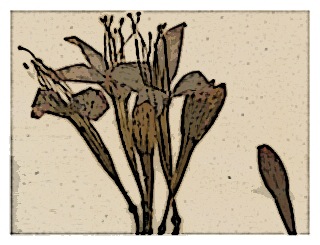
Seeds—Unknown.
Chromosomes—Unknown.
Authors—Hemsley 1876.
Original publication—J. Bot. 14: 69 1876.
Synonyms—None.
Herbarium Specimens—Kew.
F. juntasensis Kuntze
Bolivia. Restricted to cloud forest on the northeast slopes of the Andes in Cochabamba Department at elevations from 1,900 to 2,800 meters.
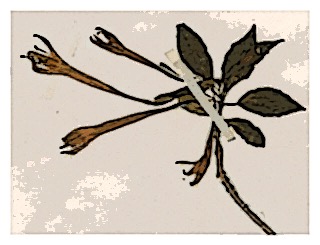
Flowering is principally in the dry season, from June to October.
Habit—Terrestrial or commonly epiphytic shrubs 0.5 to 1.5 meters tall, occasionally with small tubers. Young branches purplish, terete, 1 to 2 mm thick; older branches 4 to 20 mm thick with bark turning tan and exfoliating in strips or flakes.
Leaves—Opposite or less often ternate, membranous, (narrowly) ovate, 35 to 110 mm long, 15 to 50 mm wide, apex acuminate, base acute to rounded, glabrous to sparsely puberulent when young, often purplish below; margin subentire to serrulate, secondary veins 5 to 7 on either side of the midvein. Petioles 5 to 9 mm long. Stipules triangular to lanceolate, 2 to 3 mm long, 1.5 to 2.5 mm wide, occasionally connate.
 Flowers—Few, axillary or grouped at branch tips, pedicels slender, 20 to 75 mm long, ovary oblong, greenish, 5 to 10 mm long, 2 to 3 mm wide, floral tube funnelform, 25 to 50 mm long, 2 to 4 mm wide at the base, slightly constricted in the lower 113, then widened until 8 to 10 mm wide at the rim, glabrous outside, villous inside in the lower 113 above the nectary, sepals ovate-lanceolate, 14 to 25 mm long, 4 to 8 mm wide, apex acute to acuminate, connate for 3 to 4 mm at the base, divergent to recurred at anthesis. Tube and sepals deep lavender to rose violet. Nectary lustrous green to purplish, 4 to 5 mm high, filaments purple, the antesepalous ones 9~21 mm long, the antepetalous ones 6 to 16 mm long, anthers oblong, yellow, 3 to 4.5 mm long, 1.5 to 2.5 mm wide, style light purple, villous for most of its length, stigma green, 2.5 to 4 mm long, 2 to 3 mm wide, 4-cleft at apex, exserted 4 to 8 mm beyond the any anthers.
Flowers—Few, axillary or grouped at branch tips, pedicels slender, 20 to 75 mm long, ovary oblong, greenish, 5 to 10 mm long, 2 to 3 mm wide, floral tube funnelform, 25 to 50 mm long, 2 to 4 mm wide at the base, slightly constricted in the lower 113, then widened until 8 to 10 mm wide at the rim, glabrous outside, villous inside in the lower 113 above the nectary, sepals ovate-lanceolate, 14 to 25 mm long, 4 to 8 mm wide, apex acute to acuminate, connate for 3 to 4 mm at the base, divergent to recurred at anthesis. Tube and sepals deep lavender to rose violet. Nectary lustrous green to purplish, 4 to 5 mm high, filaments purple, the antesepalous ones 9~21 mm long, the antepetalous ones 6 to 16 mm long, anthers oblong, yellow, 3 to 4.5 mm long, 1.5 to 2.5 mm wide, style light purple, villous for most of its length, stigma green, 2.5 to 4 mm long, 2 to 3 mm wide, 4-cleft at apex, exserted 4 to 8 mm beyond the any anthers.
Fruit—The (immature) berry is oblong, purplish, 16 to 18 mm long and 8 to 10 mm wide.
Seeds—Unknown.
Chromosomes—Gametic chromosome number n = 22.
Authors—Kuntze 1898.
Original publication—Revis. Gen. Pl. 3(2): 97 1898.
Synonym: F. steinbachii, Johnston 1925.
Herbarium Specimens—New York 1, New York 2.
F. membranacea Hemsl.
Venezuelan Andes. In subpáramo and cloud forest in Mérida and Trujillo States at elevations from (2,600 to) 2,750 to 3,400 meters.
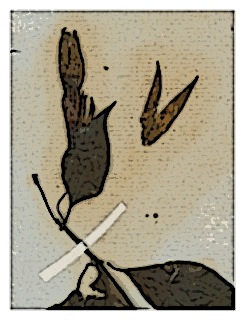
Flowering is mostly in the dry season, from January to April.
Habit—Terrestrial shrubs one to two meters tall, sometimes climbing to six meters above ground, growing in rocks, or epiphytic in trees to ten meters above ground; thickened roots to 20 mm thick or small tubers to 2 cm in diameter sometimes present. Branchlets red-pink to dark purple, 2 to 5 mm thick, older stems 5 to 25 mm thick, with freely peeling, flaky, pale tan bark.
Leaves—Opposite or temate, sometimes subopposite, membranous, ovate-elliptic, 50 to 100 mm long, 18 to 50 mm wide, apex (sub to) acuminate, base rounded to acute, subglossy green and mostly glabrous above, pale green and subglabrous below;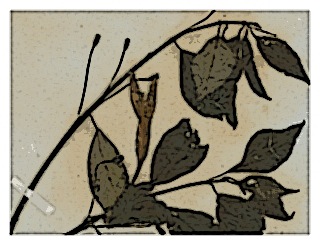 margin subentire to denticulate, secondary veins 6 to 8 on either side of the midvein. Petiole 10 to 35 mm long. Stipules lance-triangular, 2 to 2.5 mm long, 1 to 2 mm wide.
margin subentire to denticulate, secondary veins 6 to 8 on either side of the midvein. Petiole 10 to 35 mm long. Stipules lance-triangular, 2 to 2.5 mm long, 1 to 2 mm wide.
Flowers—Two to twelve per shoot, axillary or grouped toward the branch tips, pedicels slender, usually green, 30 to 55 (to 75) mm long, ovary cylindrical, 6 to 7 mm long, 2 to 4 mm wide, lustrous green or rose-colored, floral tube funnelform, (30 to) 36 to 51 mm long, 2.5 to 4 mm wide at base, narrowed slightly in lower 113, then widened until 7 to 12 mm wide at the rim, mostly glabrous outside, pilose inside in lower 113, sepals ovate-lanceolate 17 to 25 mm long, 5 to 11 mm wide, apex acute, connate for 58 mm at base, lobes often split open before anthesis With stigma exserted, spreading at anthesis. Tube red-pink, sepals usually pale green in upper Ih. Nectary green, lustrous, 4 to 5 mm high, filaments usually green, antesepalous ones 9 to 15 (to 20) mm long, the antepetalous ones 7 to 11 (to 16) mm long, anthers oblong, yellow, 3.5 to 4.5 mm long, 2 to 3 wide, style retrorse villous in lower 113, exserted 10 to 15 mm beyond the anthers, stigma clavate, 2.5 to 3.5 mm long, about 2 mm wide, green.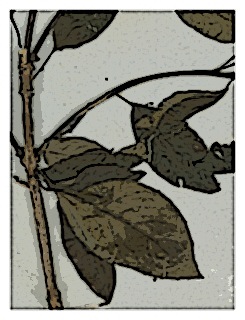
Fruit—The berry is cylindrical, 16 to 18 mm long, 11 to 12 mm wide, and shiny light red when ripe.
Seeds—Mostly 60 to 70 per berry, triangular-ovate in outline, about 2 mm long, 1.3 to 1.7 mm wide, land light brown.
Chromosomes—Gametic chromosome number n = 11.
Authors—Hemsley 1876.
Original publication—J. Bot. 14: 70 1876.
Synonyms—None.
Herbarium Specimens—Kew.
F. mezae P.E.Berry & Hersen
Peru. Known only from the type specimen found growing along a stream in a "quebrada antes de Utao" (a gulch or ravine before Utao) in Huánuco Province at 2,430 meters in elevation.
The species was named in honor of Irene Meza (fl. 1965). In 1965, Meza made a single collection (No. 360) of this apparently very rare fuchsia. The plant had only begun to leaf out after the dry season. A specimen was sent to the Missouri Botanical Garden where it remained unrecognized until described as a new species in 1999. Other than various plant collections credited to Meza in Missouri, as well as at the Herbarium of the University of San Marcos in Lima, no further information on the collector seems to be available at this time.
The full flowering period has not been described. The beginning of leaf and flower is in early October when the type was collected on October 4.
Habit—Shrub about one-half meter tall, stems erect and mostly bare of leaves, to 5 mm in diameter, lower internodes 5 to 6 cm long, leaf scars opposite or ternate; new flush of leaves and flowers subterminal on short side branches 1.5 to 4 cm long.
Leaves—Mostly opposite, young expanding blades densely pubescent with ± erect whitish trichomes 0.5 to 0.7 mm long, blades ovate, 2 to 4 cm long, 1.5 to 2 cm wide, with 7 to 9 secondary veins per side, densely pubescent on lower side, sparsely pubescent on upper surface, margins glandular-denticulate; petioles 7 to 14 mm long; stipules brown, triangular, 1 mm long, 1 mm wide.
Flowers—Axillary, preanthesal, pedicels 15 to 20 mm long, the largest flower with floral tube 40 mm long, 2 to 2.5 mm wide at the base, gradually tapered to about 5 mm wide at the base of the sepals, pink and pubescent outside, inside with a nectariferous band lining the basal 3 mm of the tube, sepals 10 to 13 mm long, basally connate in the lower half to third, green in the distal half and broader than the floral tube, sepals broadly acute at the apex, about 4 mm wide at their widest, no petals, eight stamens, the antesepalous filaments about 10 mm long, the alternating series about 6 mm long, anthers oblong, 3 mm long, 1.5 mm wide, ovary narrowly cylindrical, 8 to 9 mm long, style pubescent in lower third, stigma clavate, 2 mm long, 1.5 mm wide.
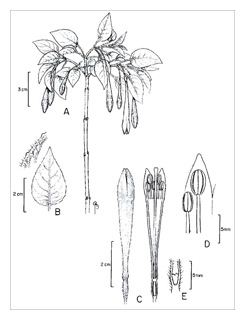
Fruit—Unknown.
Seeds—Unknown.
Chromosomes—Unknown.
Authors—Berry & Hermsen 1999.
Original publication—Novon 9: 480 1999.
Synonyms—None.
Herbarium Specimens—Holotype at Missouri Botanical Garden. Not on line.
(Illustration—Berry & Hermsen, Novon 9: 480 1999.)
F. nana P.E.Berry
Bolivia. Endemic to upper cloud forest in Cochabamba Department at elevations from (2,000 to) 3,000 to 3,700 meters.
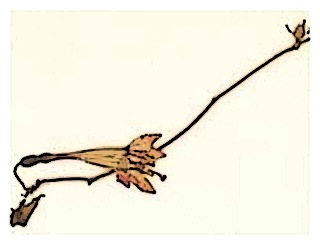
Flowering is principally in the dry season, from (April to) July to November.
Habit—Erect to creeping subshrubs 3 to 10 dm tall in rocks, or epiphytic in trees, with stoloniferous stems 2 to 8 dm long and numerous ellipsoid, copper-colored tubers lateral to the stem. Branchlets glabrous to loosely pilose, terete, 1.5 to 3 mm thick, reddish to copper; older stems 2.5 to 4 mm thick, with freely exfoliating bark.
Leaves—alternate, usually absent when flowering, membranous, (narrowly) lance-ovate, 20 to 35 mm long, 10 to 20 mm wide, apex acuminate, base rounded, glabrous above, usually pilose along the nerves below and sometimes purple-tinged; margin remotely denticulate, secondary veins 4 to 5 on either side of the midvein. Petioles 7 to 11 mm long. Stipules filiform, 1.5 to 2mm long, deciduous.
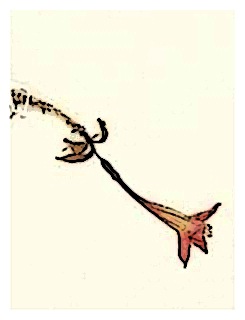
Flowers—few and axillary near the tips of young shoots, pedicels slender, glabrous, 10 to 14 (to 19) mm long, ovary cylindrical to ellipsoid, 7 to 7.5 mm long, 2 to 3 (to 4) mm wide, lustrous cherry red, glabrous to pilose, floral tube funnelform, 21 to 29 (to 31) mm long, about 3 mm wide and more or less bulbous at the base, constricted above the base to about 2 mm wide, then widened above until 7 to 8 mm wide at the mouth, glabrous to sparsely pilose outside, pilose inside in lower Ih, sepals lanceovate, 12 to 14 (to 16) mm long, 5 to 7 (to 8) mm wide, apex acute to obtuse, connate for 2 to 3 mm at the base, divergent at anthesis. Tube and sepals bright red-pink, with a dark purple ring usually present around the mouth of the tube. Nectary 2 to 3 mm high, filaments red, the antesepalous ones 8 to 10 mm long, the antepetalous ones 6 to 8 mm long, anthers ellipsoid, cream, 2 to 2.5 mm long, 1 to 2 mm wide, style red-pink, densely retrorse villous in lower half, stigma green, globose, about 1.5 mm long and wide, exserted 5 to 10 mm beyond the anthers.
Fruit—The young berry is ellipsoid, 11 mm long, and 6 mm wide.
Seeds—Unknown.
Chromosomes—Unknown.
Authors—Berry 1985.
Original publication—Ann. Missouri Bot. Gard. 72: 243 1985.
Synonyms—None.
Herbarium Specimens—New York.
F. pilaloensis P.E.Berry
Ecuador. Known only from cloud forest above Pilalo, Provo Cotopaxi Province, at elevations from 2,400 to 3,150 meters.
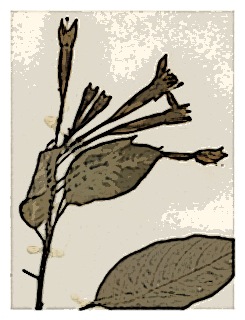 Full flowering period not described. Known to be in flower in June and July.
Full flowering period not described. Known to be in flower in June and July.
Habit—Terrestrial shrubs one half to 1one meter tall or lianas or epiphytes with long, hanging branches to eight meters high in trees; tubers sometimes present or else thickened stems 10 to 20 mm in diameter. Branchlets terete, dull purple-green, densely pilulose, 2 to 4 mm thick; older branches reddish purple, freely exfoliating.
Leaves—Usually alternate, occasionally opposite or subopposite, membranous, narrowly ovate, 40 to 120 mm long, 25 to 54 meters wide, often unequal on either side of the margin, apex acuminate, base acute to rounded, subglabrous to scattered pilose above, pilose below along nerves and margins; margin subentire to denticulate, secondary veins 6 to 9 on either side of the midvein. Petioles pubescent, 15 to 38 mm long. Stipules filiform, about 2 mm long, 0.2 to 0.4 mm wide, deciduous.
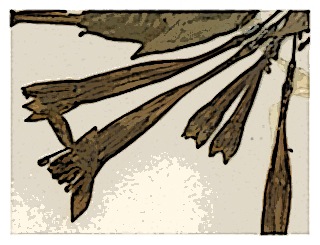 Flowers—Few to many, grouped towards the tip of branches or axillary branchlets, sometimes subtended by reduced leaves. Pedicels pilose, usually pink, 15 to 22 mm long, ovary cylindrical, 5 to 7 mm long, about 2 mm wide, dull purple, pubescent, floral tube narrowly funnelform, 44 to 53 mm long, 3 to 4.5 mm wide and bulbous at the base, then narrowed to 2 to 3 mm wide in lower third and gradually widened above until 6 to 10 mm wide at the rim, densely pilose outside, pilose inside in lower 113, sepals narrowly ovate, 13 to 20 mm long, 7 to 8 mm wide, apex acute, connate at base for 4 to 7 mm, lobes strongly spreading at anthesis. Tube pale pink, sepals whitish to pale pink, sometimes greenish in bud. Nectary green purple, lustrous, 3 to 4 mm high, filaments dull green, the antesepalous ones 12 to 15 mm long, the antepetalous ones 7 to 9 mm long, anthers oblong, yellow, 3 to 4 mm long, 2.5 to 3 mm wide, style pale pink, densely retrorse villous in lower half, stigma globose, green, about 2 mm long, 2 to 2.5 mm wide, slightly 4-cleft at the apex.
Flowers—Few to many, grouped towards the tip of branches or axillary branchlets, sometimes subtended by reduced leaves. Pedicels pilose, usually pink, 15 to 22 mm long, ovary cylindrical, 5 to 7 mm long, about 2 mm wide, dull purple, pubescent, floral tube narrowly funnelform, 44 to 53 mm long, 3 to 4.5 mm wide and bulbous at the base, then narrowed to 2 to 3 mm wide in lower third and gradually widened above until 6 to 10 mm wide at the rim, densely pilose outside, pilose inside in lower 113, sepals narrowly ovate, 13 to 20 mm long, 7 to 8 mm wide, apex acute, connate at base for 4 to 7 mm, lobes strongly spreading at anthesis. Tube pale pink, sepals whitish to pale pink, sometimes greenish in bud. Nectary green purple, lustrous, 3 to 4 mm high, filaments dull green, the antesepalous ones 12 to 15 mm long, the antepetalous ones 7 to 9 mm long, anthers oblong, yellow, 3 to 4 mm long, 2.5 to 3 mm wide, style pale pink, densely retrorse villous in lower half, stigma globose, green, about 2 mm long, 2 to 2.5 mm wide, slightly 4-cleft at the apex.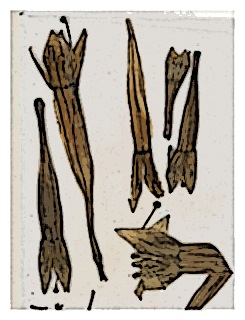
Fruit—Berry 4-angled before maturity, oblong, verrucose, purplish; mature berry not seen.
Seeds—Unknown.
Chromosomes—Unknown.
Authors—Berry 1985.
Original publication—Ann. Missouri Bot. Gard. 72: 244 1985.
Synonyms—None.
Herbarium Specimens—California Academy.
F. salicifolia Hemsl.
Southern Peru & Bolivia. In cloud forest in Cuzco and Puno Departments in Southern Peru and La Paz Department in Bolivia at elevations from (2,000 to) 2,500 to 2,900 meters.
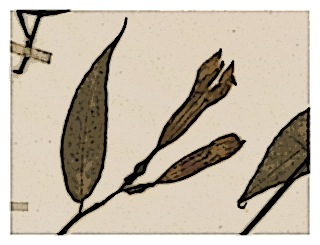
Flowers appear in the dry season, principally from July to October.
Habit—Epiphytic shrubs on tree trunks, occasionally growing in rocks. Stems sometimes stoloniferous, with globose-ellipsoid tubers 2 to 3 cm in diameter, the stems often growing down tree trunks for several meters under moss. Branchlets terete 24 mm thick, smooth reddish, subglabrous to lightly pubescent; older stems 5 to 15 mm thick with freely exfoliating bark, often 1 to 3 meters long and hanging when epiphytic.
Leaves—Alternate, firmly membranous, (narrowly) lanceolate, 60135 (to 160) mm long, 18 to 37 (to 40) mm wide, apex generally long acuminate, base acute to rounded and often unequal, pale green and subglabrous above, light green to purplish and subglabrous below; margin remotely denticulate, secondary veins 7 to 9 on either side of the midvein. Petioles 5 to 20 (to 30) mm long. Stipules filiform, 1.5 to 2 mm long, about 0.3 mm wide, deciduous.
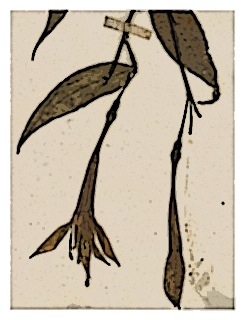
Flowers—Generally few, axillary or clustered near branch tips, pedicels slightly pubescent, 12 to 30 mm long, ovary (narrowly) cylindrical, about 11 mm long, about 2.5 mm wide, dull green, puberulent, floral tube narrowly funnelform, 40 to 54 (to 60) mm long, 34 (to 5) mm wide and more or less bulbous at the base, then narrowed to 1.5 to 2 (to 2.5) mm in the lower 113 and gradually widened above ,until 710 mm wide at the rim, glabrous to puberulent outside, villous inside in lower 113, sepals narrowly ovate, 23 to 30 mm long, 6 to 10 mm wide, apex acute to subacuminate, base connate for 24 (to 5) mm, spreading-divergent at anthesis, the distal portions sometimes curled back. Tube red pink, sepals similar or paler, a dark purple ring usually present at the throat of the tube. Nectary 3 to 4.5 mm high, filaments red to dark purple, the antesepalous ones 15 to 26 mm long, the antepetalous ones 12 to 20 mm long, anthers oblong, yellow, 2.5 to 3.5 mm long, 1 to 1.5 mm wide, style pink, retrorse villous in lower third, stigma globose to subclavate, dull green, about 2.5 mm long, 1.5 to 2 mm wide, exserted 6 to 12 mm beyond the anthers.
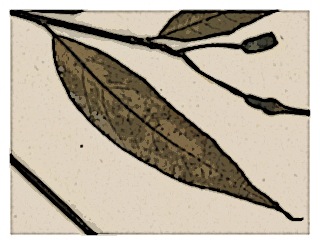 Fruit—Unknown. The mature berry not been described.
Fruit—Unknown. The mature berry not been described.
Seeds—Unknown.
Chromosomes—Unknown.
Authors—Hemsley 1876.
Original publication—J. Bot. 14: 70 1876.
Synonyms—F. tuberosa, Krause 1905; F. tuberosa var. typica, Munz 1943.
Herbarium Specimens—Berlin; Kew; Paris.
F. tillettiana Munz
Venezuelan Andes. In cloud forest in Lara, Trujillo, Merida, and Tachira States at elevations from 1,600 to 2,650 meters. (There is one doubtful collection from Colombia.)

Flowers appear mainly in the dry season, from January to April, when the plant is leafless.
Habit—Terrestrial shrubs one half to two meters tall, or growing in rocks, climbing up trees or epiphytic in trees to ten meters above ground; small, lateral tubers occasionally present in the soil on large plants. Branchlets puberulent, terete, 2 to 5 mm thick, red or copper-colored; older branches ascending on shrubs, flexuous and erect to drooping and to 10 meters long on hanging bushes, the rooted portions often to 25 mm thick, with freely peeling, flaky bark.
Leaves—Opposite or ternate, soft membranous, elliptic to narrowly ovate, (30 to) 55 to 100 mm long, (7 to) 16 to 50 mm wide, apex (sub to) acuminate, base rounded to acute, subglabrous to pruinous or puberulent above, subglabrous to puberulent and pale green below; margin subentire to serrulate, secondary veins 7 to 9 on either side of the midvein. Petioles puberulent, green or reddish, 6 to 12 (to 30) mm long. Stipules lance-triangular, 12 mm long, 1 to 1.5 mm wide.
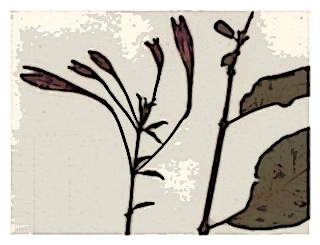 Flowers—Generally numerous at branch tips or subracemose, leaves often absent, or small bracts 15 to 30 mm long and 6 to 20 mm wide present when flowering, pedicels red-purple, 25 to 50 mm long, ovary cylindrical, more or less sulcate, 8 to 10 mm long, 2.5 to 3.5 mm wide, green to purplish, usually with glandular hairs, floral tube funnelform, 36 to 46 mm long, 2 to 5 mm wide at the base, slightly narrowed in lower third, then gradually widened until 7 to 9 (to 13) mm wide at the rim, glandular-pubescent outside, pilose inside in lower third, sepals lanceolate, 19 to 33 mm long, 4 to 6 (to 10) mm wide, apex acute, base connate for 2 to 3 mm, blunt-tipped in bud, strongly recurved at anthesis. Tube and sepals cerise or rose pink. Nectary glossy green, 3 to 4 mm high, filaments pink to cerise or dark purple, the antesepalous ones 20 to 35 mm long, the antepetalous ones 15 to 28 mm long, anthers oblong, yellow, 4 to 5 mm long, 2.5 to 3 mm wide, style pink, retrorse villous in the lower half to third, exserted 15 to 20 mm beyond the anthers, stigma green, clavate, about 3 mm long, 2 to 2.5 mm wide.
Flowers—Generally numerous at branch tips or subracemose, leaves often absent, or small bracts 15 to 30 mm long and 6 to 20 mm wide present when flowering, pedicels red-purple, 25 to 50 mm long, ovary cylindrical, more or less sulcate, 8 to 10 mm long, 2.5 to 3.5 mm wide, green to purplish, usually with glandular hairs, floral tube funnelform, 36 to 46 mm long, 2 to 5 mm wide at the base, slightly narrowed in lower third, then gradually widened until 7 to 9 (to 13) mm wide at the rim, glandular-pubescent outside, pilose inside in lower third, sepals lanceolate, 19 to 33 mm long, 4 to 6 (to 10) mm wide, apex acute, base connate for 2 to 3 mm, blunt-tipped in bud, strongly recurved at anthesis. Tube and sepals cerise or rose pink. Nectary glossy green, 3 to 4 mm high, filaments pink to cerise or dark purple, the antesepalous ones 20 to 35 mm long, the antepetalous ones 15 to 28 mm long, anthers oblong, yellow, 4 to 5 mm long, 2.5 to 3 mm wide, style pink, retrorse villous in the lower half to third, exserted 15 to 20 mm beyond the anthers, stigma green, clavate, about 3 mm long, 2 to 2.5 mm wide.
Fruit—The berry is cylindrical, usually more or less narrowed at the apex, 18 to 21 mm long, 6 to 10 mm wide, puberulent, and dull purple-green to lustrous bright red when ripe.
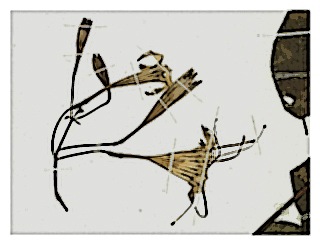
Seeds—About 50 per fruit, light tan, 1.8 to 2 mm long, and 1.3 to 1.6 mm wide.
Chromosomes—Gametic chromosome number n = 11.
Authors—Munz 1972.
Original publication—Aliso 7: 410 1972.
Synonyms—None.
Herbarium Specimens—MIssouri; New York; Smithsonian.
F. tunariensis Kuntze
Southern Peru and Bolivia. Rare in cloud forest from Ayacucho Department, Peru, to Cochabamba Department, Bolivia, at elevations from 2,400 to 3,400 meters.
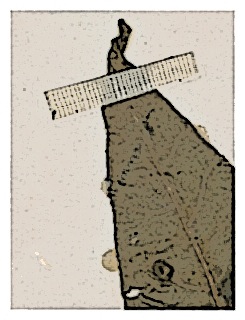
Flowers appear mostly at the end of the dry season, from September to November.
Habit—Shrub eight centimeters to one and a half meters high, growing terrestrially in humus, on rocks, or epiphytically in trees, with cylindrical-ellipsoid tubers 1 to 3 cm thick and 8 to 15 cm long usually present. Young growth velutinous, pilulose or cinereous; branchlets terete, 2 to 4 mm thick, pilulose; older branches with freely exfoliating bark.
Leaves—Opposite or less often alternate, membranous, broadly ovate to ellipticovate, 60 to 110 (to 115) mm long, 35 to 65 mm wide, apex (sub to) acuminate, base acute to cordate, subglabrous to pilulose above, scattered to densely pubescent below, especially along the nerves; margin remotely denticulate, secondary veins 69 on either side of midvein. Petioles pubescent, (10 to) 15 to 33 mm long. Stipules narrowly triangular, about 1.5 mm long, deciduous.
 Flowers—Generally few and axillary towards young branch tips, pedicels finely pubescent, 15 to 30 (to 50) mm long, ovary cylindrical, velutinous to pilulose, 9 to 11 mm long, 2.5 to 3 mm wide, floral tube funnelform, (36 to) 44 to 56 mm long, 3.5 to 4.5 mm wide and more or less bulbous at the base, then slightly constricted to about 3 mm wide and widened gradually above until 6 to 1 0 mm wide at the rim, finely pubescent outside, villous inside for most of length, sepals lanceolate to (narrowly) ovate, 17 to 25 mm long, 7 to 8 (to 9) mm wide, apex acute to acuminate, connate for 3 to 4 mm at the base, divergent at anthesis. Tube and sepals bright red pink to light orange. Nectary 2.5 to 4 mm high, filaments greenish, the antesepalous ones 14 to 20 mm long, the antepetalous ones 8 to 13 mm long, anthers oblong-ellipsoid, yellow, 3 to 3.5 mm long, about 2 mm wide, style orange to pink, villous for most of length, stigma globose, green, 2 to 3 mm long, about 2 mm wide, exserted 6 to 20 mm beyond the stamens.
Flowers—Generally few and axillary towards young branch tips, pedicels finely pubescent, 15 to 30 (to 50) mm long, ovary cylindrical, velutinous to pilulose, 9 to 11 mm long, 2.5 to 3 mm wide, floral tube funnelform, (36 to) 44 to 56 mm long, 3.5 to 4.5 mm wide and more or less bulbous at the base, then slightly constricted to about 3 mm wide and widened gradually above until 6 to 1 0 mm wide at the rim, finely pubescent outside, villous inside for most of length, sepals lanceolate to (narrowly) ovate, 17 to 25 mm long, 7 to 8 (to 9) mm wide, apex acute to acuminate, connate for 3 to 4 mm at the base, divergent at anthesis. Tube and sepals bright red pink to light orange. Nectary 2.5 to 4 mm high, filaments greenish, the antesepalous ones 14 to 20 mm long, the antepetalous ones 8 to 13 mm long, anthers oblong-ellipsoid, yellow, 3 to 3.5 mm long, about 2 mm wide, style orange to pink, villous for most of length, stigma globose, green, 2 to 3 mm long, about 2 mm wide, exserted 6 to 20 mm beyond the stamens.
 Fruit—Unknown. The mature berry has not been described.
Fruit—Unknown. The mature berry has not been described.
Seeds—Unknown.
Chromosomes—Gametic chromosome number n = 11.
Authors—Kuntze 1898.
Original publication—Revis. Gen. Pl. 3(2): 98 1898.
Synonyms—F. mattoana, Krause 1906.
Herbarium Specimens—Field Museum, New York.
Bolivia and Peru. Found on the eastern slopes of the Peruvian Andes from San Martín Department south to Puno Department and in Bolivia, La Paz and Cochabamba Departments in upper cloud forest and the lower reaches of the Puna, on rocks, tree trunks and sphagnum banks at elevations from (2,800 to) 3,200 to 3,850 (to 4,200) meters but most common above 3,600 meters.

Habit—Prostrate to hanging subshrubs in rock crevices or on the edge of banks rich in sphagnum or humus, or vine-like epiphytes on moist tree trunks. Tubers ellipsoid to cylindrical, 2 to 8 cm long and 1 to 5 cm thick, covered by copper-tan, flaking bark, often interconnected by slender stems. Stoloniferous shoots 2 to 12 dm long when epiphytic (lacking when terrestrial), 2 to 4 mm thick with freely exfoliating red-copper bark; leaves and flowers borne on short, lateral, knotty-tortuous stems with tightly packed leaf and pedicel scars, these stems rarely more than 4 cm long, 3 to 8 mm thick, dull gray, pilose to hirsute.
Leaves—Alternate and usually tightly clustered at the branch tips, mostly deciduous at anthesis or present on plants flowering in shady habitats, soft membranous, subcordate to ovate-elliptic, 60 to 120 (to 150) mm long, 35 to 65 mm wide, apex acute to acuminate, base rounded to obtuse or subcordate, densely pilose-hirsute when young, green and subglabrous to strigose above at maturity, slightly paler and pilose below, with appressed, densely villous hairs along veins; margin subentire to denticulate, secondary veins 6 to 8 on either side of the midvein; petiole 25 to 50 (to 70) mm long, 2 to 3.5 mm thick, reddish, pilose; stipules filiform, 2 to 3 mm long, deciduous.

Fruit—The berry is oblong, red, subtetragonous, 17 to 25 mm long, 8 to 12 mm thick, subglabrous to densely hirsute, and more or less verrucose.
Seeds: Many-seeded.
Chromosomes—Gametic chromosome number n = 22.
Authors—Ruiz & Pavon 1802.
Original publication—Fl. Peruv. 3: 89 1802.
Synonyms—F. macrantha Hook. 1846; F. hirsuta Hemsl. 1876; F. unduavensis Munz 1943.
Herbarium Specimens—Field Museum 1, Field Museum 2; Kew 1, Kew 2, Kew 3, Kew 4; New York; Smithsonian.

Northwestern Peru. Rare and endemic to scrub vegetation on the Pacific-facing slopes of the Andes in Cajamarca, Lambayeque, and Piura Departments at elevations from 1,100 to 1,700 meters.
Habit—Erect to scandent shrubs one half to three meters tall. Branchlets terete, 1.5 to 3 mm thick, puberulent to pilose; older stems 5 to 40 mm thick, with exfoliating bark.
Leaves—Opposite or ternate, membranous, elliptic, 26 to 100 mm long, 14 to 15 mm wide, apex and base acute, subglabrous to puberulent above, puberulent below, especially on the veins; margin subentire to serrulate, secondary veins 6 to 14 on either side of the midvein. Petioles strigose, (2 to) 48 mm long. Stipules lanceolate, about 1 mm long, about 0.5 mm wide.

Flowers—Generally numerous on terminal and axillary racemes with. small, deciduous, lance-filiform bracts, rachis (15 to) 25 to 35 mm long, pedicels puberulent, 3 to 4 mm long, Ovary cylindrical, 3 to 4 mm long, 1 to 1.5 mm wide, puberulent to pilose, floral tube narrowly funnelform, 18 to 20 mm long, 2 to 3 mm wide at the base, narrowed to about 1.5 mm wide in the lower 113, then gradually widened to about 4 mm wide at the rim, lightly puberulent to pilose outside, retrorse villous inside in lower 113, sepals oblonglanceolate, 5 to 7 mm long, 2.5 to 3 mm wide, obtuse to acute at the apex, connate for about 1.5 mm at the base, spreading at anthesis. Tube rose pink to lavender, sepals greenish (in bud) to dull purple. Nectary about 3 mm high, filaments green, the antesepalous ones 3.5 to 6 (to 7) mm long, the antepetalous ones 2 to 5 mm long, anthers broadly elliptic, yellow,

Fruit—The immature berry is oblong, 8 mm long and 5 mm wide.
Seeds: About 50 per berry
Chromosomes—Gametic chromosome number n = 11.
Authors—Schulze-Menz 1940.
Original publication—Notizbl. Bot. Gart. Berlin-Dahlem 15: 137 1940.
Synonyms—None.
Herbarium Specimens—Field Museum; California Academy; Smithsonian.
F. chloroloba I.M.Johnst.
Southern Peru. Endemic to cloud forest in several valleys in Provo Paucartambo and Provo Quispicanchis Departments, Cuzco at elevations from (1,600 to) 2,200 to 2,800 meters.

Flowers appear in the dry season, principally from May to October.
Habit—Shrubs one to two meters high, usually growing in rocks or epiphytic on trees, with globose to ellipsoid tubers 1 to 4 cm thick. Branchlets terete, smooth, purplish, 1.5 to 5 mm thick; older stems 0.5 to 2 meters long, 5 to 18 mm thick, with freely exfoliating bark.
Leaves—Alternate, usually lacking at anthesis, membranous, narrowly lance-ovate, 60 to 120 mm long, 20 to 55 (to 60) mm wide, apex acuminate, base cordate to subcordate, glabrous on both sides; margin subentire to remotely denticulate, secondary veins 5 to 9 on either side of the midvein. Petioles 14 to 45 mm long. Stipules filiform, about 2 mm long, 0.2 to 0.3 mm wide, deciduous.
Flowers—Few to numerous, axillary or clustered at the tips of young shoots, pedicels dull red or green, 26 to 60 (to 70) mm long, ovary (narrowly) cylindric, 10 to 24 mm long, 2 to 4 mm wide, lustrous light green, floral tube (38 to) 41 to 51 mm long, 4 to 5 mm wide and bulbous at the base, thereupon strongly constricted to 1.5 to 2 mm wide in the lower third to quarter of the tube, then abruptly widened until 10 to 13.5 mm wide in the upper half before narrowing slightly to 9 to 11 (to 12) mm wide at the rim, glabrous outside, pilose inside in the lower quarter. Sepals lance-ovate, thin membranous, 16 to 24 mm long, 5 to 10 (to 12) mm wide, apex acute to acuminate, connate for 5 to 7 mm at the base, tetragonous in bud, spreading-divergent at anthesis. Tube glaucous, bright scarlet to light orange-pink, sepals parrot green. Nectary 6 to 8 mm high, filaments green, the antesepalous ones 10 to 16 mm

Fruit—Unknown. The mature berry not described.
Seeds—Unknown.
Chromosomes—Gametic chromosome number n = 11.
Authors—Johnston 1939.
Original publication—J. Arnold Arbor. 20: 243 1939.
Synonyms—F. tuberosa.
Herbarium Specimens—Field Museum 1, Field Museum 2.
F. garleppiana Kuntze & Wittm.
Bolivia. Endemic to cloud forest in Cochabamba Department at elevations from 2,500 to 2,950 meters.
Flowers appear principally in the dry season, when the plant leafless, from March/April to August.

Habit—Shrubs one half to four meters tall, growing epiphytically or more commonly out of rock crevices, with strongly developed cylindrical tubers 10 to 80 cm long and 2 to 4 cm thick and more or less erect branches one to two and one half meters long. Young growth densely white-pilose; branchlets terete, 2 to 4 mm thick, red-green; older stems 4 to 10 mm thick, with freely exfoliating bark.
Leaves—Alternate, usually absent at anthesis, membranous, ovate to ellipticovate, mature blades 90 to 130 mm long, 55 to 75 mm wide, apex subacuminate, base rounded to cordate, light green and subglabrous above, pilose along veins and margin below; margin subentire to remotely denticulate, secondary veins 9 to 10 on either side of the midvein. Petioles pilose, 40 to 73 mm long on mature leaves. Stipules filiform, about 2 mm long, deciduous.
Flowers—Few to many, axillary or grouped at branch tips, pedicels densely pilose, greenish pink, 7 to 30 (to 60) mm long, ovary narrowly cylindric, 7 to 8 mm long, 2 to 2.5 mm thick, densely pilose, floral tube narrowly tubular-funnelform, (45 to) 70 to 140 mm long, 3.5 to 6 (to 7) mm wide and bulbous at the base, then constricted to 2 to 2.5 mm wide and gradually widened above until 7 to 10 mm wide below the slightly constricted mouth, pilose outside, villous inside for most of length, sepals lance-ovate, 10 to 18 mm long, 5.5 to 7 (to 8) mm wide, apex acute, connate for about third of length at the base, spreading divergent at anthesis. Tube and sepals light to very pale pink, with a dark purple ring on the throat where the stamens are inserted. Nectary lustrous green-purple, 4 to 6 mm high, filaments green, the antesepalous ones 10 to 12 mm long, the antepetalous ones 8 to 9 mm long, anthers yellow, 3 to 4 mm long, 1.5 to 2 mm wide, style light pink, villous for most of the length, stigma green, globose, 2 to 2.5 mm long, 2.5 to 3 mm wide.

Fruit—The young berries narrowly cylindric, about 22 mm long and about 4 mm wide.
Seeds—Unknown.
Chromosomes—Gametic chromosome number n = 11.
Authors—Kuntze & Wittmack 1893.
Original publication—Gartenflora 42: 461 1893.
Synonyms—None.
Herbarium Specimens—New York 1, New York 2.
F. huanucoensis P.E.Berry
Central Peru. Known only from the type locality in cloud forest at the Carpish Divide in Huánuco Department at elevations from 2,750 to 2,950 meters.

Flowering period unrecorded: Known to be in flower from October to November.
Habit—Low, scandent shrubs with oppositely branched stems. Branchlets subterete, 1 to 3 mm thick, purplish, pilose with white hairs; older branches pilose, with lustrous purple bark splitting longitudinally.
Leaves—Present at anthesis, opposite, firmly membranous, narrowly ellipticovate, 40 to 80 mm long, 18 to 30 mm wide, apex subacuminate, base acute to rounded, apparently dark green and subglabrous above, paler below with pilose midvein and margin; margin subentire, secondary veins 6 to 10 on either side of the midvein. Petioles strigose, purplish, 6 to 10 mm long. Stipules lance-triangular, 1 to 1.5 mm long, deciduous.
Flowers—Few and axillary, close to the branch tips, pedicels slender, drooping, sparsely pilose, 24 to 35 mm long, ovary oblong, 6 to 7 mm long, about 3 mm wide, floral tube narrowly funnelform, 31 to 34 mm long, about 3.5 mm wide at the base, then gradually widened above until about 7 mm wide at the rim, subglabrous outside, pilose inside in lower Ih, sepals narrowly lanceolate, apex narrowly acute to acuminate, 22 to 23 mm long, 4 to 5 mm wide, connate for 2 to 3 mm at the base, tips strongly spreading or recurved at anthesis. Tube and sepals magenta or bright reddish pink. Nectary about 3 mm high, filaments reddish, the antesepalous ones 13 to 20 mm long, the antepetalous ones 9 to 14 mm long, anthers narrowly oblong, 3 to 4 mm long, about 2 mm wide, style reddish, pilose for most of length, stigma subclavate, barely four-cleft at the apex, about 2 mm long, about 1.5 mm wide.

Fruit—Unknown.
Seeds—Unknown.
Chromosomes—Gametic chromosome number unknown.
Authors—Berry 1985.
Original publication—Ann. Missouri Bot. Gard. 72: 235 1985.
Synonyms—None.
Herbarium Specimens—Kew 1, Kew 2.
F. inflata Schulze-Menz
Cuzco Department, Peru. Endemic to several valleys on the eastern slopes of the Andes at elevations from (2,350 to) 2,850 to 3,000 meters.
Flowering period is principally in the dry season, from June to August.

Leaves—Alternate or rarely opposite, membranous, narrowly elliptic to ovate, 55 to 135 mm long, 20 to 52 mm wide, apex acuminate, base acute to rounded or subcordate, glabrous to sparsely pubescent above, glabrous to pubescent along the veins below; margin subentire to remotely denticulate, secondary veins 6 to 9 on either side of the midvein. Petioles glabrous to canescent-velutinous, 12 to 22 (to 35) mm long. Stipules filiform, 1.5 to 2 mm long, deciduous.

Fruit—The young berries are 20 to 40 mm long and 5 to 6 mm wide.
Seeds—Unknown.
Chromosomes—Gametic chromosome number n = 11.
Authors — Schulze-Menz 1940.
Original publication—Notizbl. Bot. Gart. Berlin-Dahlem 15: 136 1940.
Synonyms—F. tuberosa, Krause; F. tuberosa var. inflata, (Schulze-Menz) Munz 1943.
Herbarium Specimens—Smithsonian 1, Smithsonian 2.
F. insignis Hemsl.
Southern Ecuador. Scarce epiphyte in cloud forest or shrub on hillsides in Bolívar, Chimborazo, and Cafiar Provinces at elevations from 2,000 to 3,240 meters.

Flowering is in the dry season when the plants is leafless, mostly from July to October.
Habit—Scandent or epiphytic vines or shrubs climbing high into trees, or terrestrial shrubs about one meter high. Branchlets smooth, purplish, pilose, 2 to 5 mm thick, with prominent, alternate leaf scars; older stems freely exfoliating in strips, with stoloniferous runners.
Leaves—Alternate, absent when flowering, membranous, ovate to broadly elliptic-ovate, just two young leaves seen, these 4590 mm long, 30 to 40 mm wide, apex acute, base rounded, green and subglabrous above, pale green to purplish and villous below, especially along the veins; margin subentire to remotely denticulate, secondary veins 6 to 7 on either side of the midvein. Petiole 1 to 1.5 mm thick, 9 to 18 mm long.
Flowers—Few to numerous and clustered at the tips of new shoots, pedicels pilose, 10 to 23 mm long, ovary narrowly cylindrical, pilose, 8 to 10 mm long, 2 to 3 mm wide, floral tube funnelform, (38 to) 40 to 54 (to 62) mm long, 4 to 6 mm wide and bulbous at the base, constricted to 2 to 2.5 mm in lower 113, then gradually widened until 7 to 11 mm wide at the rim, pilose outside and inside in lower 113, sepals oblong-lanceolate, 24 to 37 mm long, 7 to 12 mm wide, usually widest in the middle, apex acute to obtuse, connate for 3 to 4 mm at the base, strongly recurved at anthesis. Tube and sepals bright scarlet or orange-red. Nectary 4 to 6 mm high, filaments green (side Rose &Rose 22230), the antesepalous ones 30 to 40 mm wide, the antepetalous ones 25 to 35 mm long, anthers oblong, 4 to 5 mm long, 2 to 2.5 mm wide, style densely retrorse villous in the lower 113, exserted 10 to 15 mm beyond the anthers, stigma globose, about 2 mm long and wide.
Fruit—The immature berry is narrowly cylindrical, verrucose, 18 to 20 mm long and 5 to 7 mm wide.

Seeds—Unknown.
Chromosomes—Unknown.
Authors—Hemsley 1876.
Original publication—J. Bot. 14: 69 1876.
Synonyms—None.
Herbarium Specimens—Kew.
F. juntasensis Kuntze
Bolivia. Restricted to cloud forest on the northeast slopes of the Andes in Cochabamba Department at elevations from 1,900 to 2,800 meters.

Flowering is principally in the dry season, from June to October.
Habit—Terrestrial or commonly epiphytic shrubs 0.5 to 1.5 meters tall, occasionally with small tubers. Young branches purplish, terete, 1 to 2 mm thick; older branches 4 to 20 mm thick with bark turning tan and exfoliating in strips or flakes.
Leaves—Opposite or less often ternate, membranous, (narrowly) ovate, 35 to 110 mm long, 15 to 50 mm wide, apex acuminate, base acute to rounded, glabrous to sparsely puberulent when young, often purplish below; margin subentire to serrulate, secondary veins 5 to 7 on either side of the midvein. Petioles 5 to 9 mm long. Stipules triangular to lanceolate, 2 to 3 mm long, 1.5 to 2.5 mm wide, occasionally connate.

Fruit—The (immature) berry is oblong, purplish, 16 to 18 mm long and 8 to 10 mm wide.
Seeds—Unknown.
Chromosomes—Gametic chromosome number n = 22.
Authors—Kuntze 1898.
Original publication—Revis. Gen. Pl. 3(2): 97 1898.
Synonym: F. steinbachii, Johnston 1925.
Herbarium Specimens—New York 1, New York 2.
F. membranacea Hemsl.
Venezuelan Andes. In subpáramo and cloud forest in Mérida and Trujillo States at elevations from (2,600 to) 2,750 to 3,400 meters.

Flowering is mostly in the dry season, from January to April.
Habit—Terrestrial shrubs one to two meters tall, sometimes climbing to six meters above ground, growing in rocks, or epiphytic in trees to ten meters above ground; thickened roots to 20 mm thick or small tubers to 2 cm in diameter sometimes present. Branchlets red-pink to dark purple, 2 to 5 mm thick, older stems 5 to 25 mm thick, with freely peeling, flaky, pale tan bark.
Leaves—Opposite or temate, sometimes subopposite, membranous, ovate-elliptic, 50 to 100 mm long, 18 to 50 mm wide, apex (sub to) acuminate, base rounded to acute, subglossy green and mostly glabrous above, pale green and subglabrous below;

Flowers—Two to twelve per shoot, axillary or grouped toward the branch tips, pedicels slender, usually green, 30 to 55 (to 75) mm long, ovary cylindrical, 6 to 7 mm long, 2 to 4 mm wide, lustrous green or rose-colored, floral tube funnelform, (30 to) 36 to 51 mm long, 2.5 to 4 mm wide at base, narrowed slightly in lower 113, then widened until 7 to 12 mm wide at the rim, mostly glabrous outside, pilose inside in lower 113, sepals ovate-lanceolate 17 to 25 mm long, 5 to 11 mm wide, apex acute, connate for 58 mm at base, lobes often split open before anthesis With stigma exserted, spreading at anthesis. Tube red-pink, sepals usually pale green in upper Ih. Nectary green, lustrous, 4 to 5 mm high, filaments usually green, antesepalous ones 9 to 15 (to 20) mm long, the antepetalous ones 7 to 11 (to 16) mm long, anthers oblong, yellow, 3.5 to 4.5 mm long, 2 to 3 wide, style retrorse villous in lower 113, exserted 10 to 15 mm beyond the anthers, stigma clavate, 2.5 to 3.5 mm long, about 2 mm wide, green.

Fruit—The berry is cylindrical, 16 to 18 mm long, 11 to 12 mm wide, and shiny light red when ripe.
Seeds—Mostly 60 to 70 per berry, triangular-ovate in outline, about 2 mm long, 1.3 to 1.7 mm wide, land light brown.
Chromosomes—Gametic chromosome number n = 11.
Authors—Hemsley 1876.
Original publication—J. Bot. 14: 70 1876.
Synonyms—None.
Herbarium Specimens—Kew.
F. mezae P.E.Berry & Hersen
Peru. Known only from the type specimen found growing along a stream in a "quebrada antes de Utao" (a gulch or ravine before Utao) in Huánuco Province at 2,430 meters in elevation.
The species was named in honor of Irene Meza (fl. 1965). In 1965, Meza made a single collection (No. 360) of this apparently very rare fuchsia. The plant had only begun to leaf out after the dry season. A specimen was sent to the Missouri Botanical Garden where it remained unrecognized until described as a new species in 1999. Other than various plant collections credited to Meza in Missouri, as well as at the Herbarium of the University of San Marcos in Lima, no further information on the collector seems to be available at this time.
The full flowering period has not been described. The beginning of leaf and flower is in early October when the type was collected on October 4.
Habit—Shrub about one-half meter tall, stems erect and mostly bare of leaves, to 5 mm in diameter, lower internodes 5 to 6 cm long, leaf scars opposite or ternate; new flush of leaves and flowers subterminal on short side branches 1.5 to 4 cm long.
Leaves—Mostly opposite, young expanding blades densely pubescent with ± erect whitish trichomes 0.5 to 0.7 mm long, blades ovate, 2 to 4 cm long, 1.5 to 2 cm wide, with 7 to 9 secondary veins per side, densely pubescent on lower side, sparsely pubescent on upper surface, margins glandular-denticulate; petioles 7 to 14 mm long; stipules brown, triangular, 1 mm long, 1 mm wide.
Flowers—Axillary, preanthesal, pedicels 15 to 20 mm long, the largest flower with floral tube 40 mm long, 2 to 2.5 mm wide at the base, gradually tapered to about 5 mm wide at the base of the sepals, pink and pubescent outside, inside with a nectariferous band lining the basal 3 mm of the tube, sepals 10 to 13 mm long, basally connate in the lower half to third, green in the distal half and broader than the floral tube, sepals broadly acute at the apex, about 4 mm wide at their widest, no petals, eight stamens, the antesepalous filaments about 10 mm long, the alternating series about 6 mm long, anthers oblong, 3 mm long, 1.5 mm wide, ovary narrowly cylindrical, 8 to 9 mm long, style pubescent in lower third, stigma clavate, 2 mm long, 1.5 mm wide.

Fruit—Unknown.
Seeds—Unknown.
Chromosomes—Unknown.
Authors—Berry & Hermsen 1999.
Original publication—Novon 9: 480 1999.
Synonyms—None.
Herbarium Specimens—Holotype at Missouri Botanical Garden. Not on line.
(Illustration—Berry & Hermsen, Novon 9: 480 1999.)
F. nana P.E.Berry
Bolivia. Endemic to upper cloud forest in Cochabamba Department at elevations from (2,000 to) 3,000 to 3,700 meters.

Flowering is principally in the dry season, from (April to) July to November.
Habit—Erect to creeping subshrubs 3 to 10 dm tall in rocks, or epiphytic in trees, with stoloniferous stems 2 to 8 dm long and numerous ellipsoid, copper-colored tubers lateral to the stem. Branchlets glabrous to loosely pilose, terete, 1.5 to 3 mm thick, reddish to copper; older stems 2.5 to 4 mm thick, with freely exfoliating bark.
Leaves—alternate, usually absent when flowering, membranous, (narrowly) lance-ovate, 20 to 35 mm long, 10 to 20 mm wide, apex acuminate, base rounded, glabrous above, usually pilose along the nerves below and sometimes purple-tinged; margin remotely denticulate, secondary veins 4 to 5 on either side of the midvein. Petioles 7 to 11 mm long. Stipules filiform, 1.5 to 2mm long, deciduous.

Flowers—few and axillary near the tips of young shoots, pedicels slender, glabrous, 10 to 14 (to 19) mm long, ovary cylindrical to ellipsoid, 7 to 7.5 mm long, 2 to 3 (to 4) mm wide, lustrous cherry red, glabrous to pilose, floral tube funnelform, 21 to 29 (to 31) mm long, about 3 mm wide and more or less bulbous at the base, constricted above the base to about 2 mm wide, then widened above until 7 to 8 mm wide at the mouth, glabrous to sparsely pilose outside, pilose inside in lower Ih, sepals lanceovate, 12 to 14 (to 16) mm long, 5 to 7 (to 8) mm wide, apex acute to obtuse, connate for 2 to 3 mm at the base, divergent at anthesis. Tube and sepals bright red-pink, with a dark purple ring usually present around the mouth of the tube. Nectary 2 to 3 mm high, filaments red, the antesepalous ones 8 to 10 mm long, the antepetalous ones 6 to 8 mm long, anthers ellipsoid, cream, 2 to 2.5 mm long, 1 to 2 mm wide, style red-pink, densely retrorse villous in lower half, stigma green, globose, about 1.5 mm long and wide, exserted 5 to 10 mm beyond the anthers.
Fruit—The young berry is ellipsoid, 11 mm long, and 6 mm wide.
Seeds—Unknown.
Chromosomes—Unknown.
Authors—Berry 1985.
Original publication—Ann. Missouri Bot. Gard. 72: 243 1985.
Synonyms—None.
Herbarium Specimens—New York.
F. pilaloensis P.E.Berry
Ecuador. Known only from cloud forest above Pilalo, Provo Cotopaxi Province, at elevations from 2,400 to 3,150 meters.

Habit—Terrestrial shrubs one half to 1one meter tall or lianas or epiphytes with long, hanging branches to eight meters high in trees; tubers sometimes present or else thickened stems 10 to 20 mm in diameter. Branchlets terete, dull purple-green, densely pilulose, 2 to 4 mm thick; older branches reddish purple, freely exfoliating.
Leaves—Usually alternate, occasionally opposite or subopposite, membranous, narrowly ovate, 40 to 120 mm long, 25 to 54 meters wide, often unequal on either side of the margin, apex acuminate, base acute to rounded, subglabrous to scattered pilose above, pilose below along nerves and margins; margin subentire to denticulate, secondary veins 6 to 9 on either side of the midvein. Petioles pubescent, 15 to 38 mm long. Stipules filiform, about 2 mm long, 0.2 to 0.4 mm wide, deciduous.


Fruit—Berry 4-angled before maturity, oblong, verrucose, purplish; mature berry not seen.
Seeds—Unknown.
Chromosomes—Unknown.
Authors—Berry 1985.
Original publication—Ann. Missouri Bot. Gard. 72: 244 1985.
Synonyms—None.
Herbarium Specimens—California Academy.
F. salicifolia Hemsl.
Southern Peru & Bolivia. In cloud forest in Cuzco and Puno Departments in Southern Peru and La Paz Department in Bolivia at elevations from (2,000 to) 2,500 to 2,900 meters.

Flowers appear in the dry season, principally from July to October.
Habit—Epiphytic shrubs on tree trunks, occasionally growing in rocks. Stems sometimes stoloniferous, with globose-ellipsoid tubers 2 to 3 cm in diameter, the stems often growing down tree trunks for several meters under moss. Branchlets terete 24 mm thick, smooth reddish, subglabrous to lightly pubescent; older stems 5 to 15 mm thick with freely exfoliating bark, often 1 to 3 meters long and hanging when epiphytic.
Leaves—Alternate, firmly membranous, (narrowly) lanceolate, 60135 (to 160) mm long, 18 to 37 (to 40) mm wide, apex generally long acuminate, base acute to rounded and often unequal, pale green and subglabrous above, light green to purplish and subglabrous below; margin remotely denticulate, secondary veins 7 to 9 on either side of the midvein. Petioles 5 to 20 (to 30) mm long. Stipules filiform, 1.5 to 2 mm long, about 0.3 mm wide, deciduous.

Flowers—Generally few, axillary or clustered near branch tips, pedicels slightly pubescent, 12 to 30 mm long, ovary (narrowly) cylindrical, about 11 mm long, about 2.5 mm wide, dull green, puberulent, floral tube narrowly funnelform, 40 to 54 (to 60) mm long, 34 (to 5) mm wide and more or less bulbous at the base, then narrowed to 1.5 to 2 (to 2.5) mm in the lower 113 and gradually widened above ,until 710 mm wide at the rim, glabrous to puberulent outside, villous inside in lower 113, sepals narrowly ovate, 23 to 30 mm long, 6 to 10 mm wide, apex acute to subacuminate, base connate for 24 (to 5) mm, spreading-divergent at anthesis, the distal portions sometimes curled back. Tube red pink, sepals similar or paler, a dark purple ring usually present at the throat of the tube. Nectary 3 to 4.5 mm high, filaments red to dark purple, the antesepalous ones 15 to 26 mm long, the antepetalous ones 12 to 20 mm long, anthers oblong, yellow, 2.5 to 3.5 mm long, 1 to 1.5 mm wide, style pink, retrorse villous in lower third, stigma globose to subclavate, dull green, about 2.5 mm long, 1.5 to 2 mm wide, exserted 6 to 12 mm beyond the anthers.

Seeds—Unknown.
Chromosomes—Unknown.
Authors—Hemsley 1876.
Original publication—J. Bot. 14: 70 1876.
Synonyms—F. tuberosa, Krause 1905; F. tuberosa var. typica, Munz 1943.
Herbarium Specimens—Berlin; Kew; Paris.
F. tillettiana Munz
Venezuelan Andes. In cloud forest in Lara, Trujillo, Merida, and Tachira States at elevations from 1,600 to 2,650 meters. (There is one doubtful collection from Colombia.)

Flowers appear mainly in the dry season, from January to April, when the plant is leafless.
Habit—Terrestrial shrubs one half to two meters tall, or growing in rocks, climbing up trees or epiphytic in trees to ten meters above ground; small, lateral tubers occasionally present in the soil on large plants. Branchlets puberulent, terete, 2 to 5 mm thick, red or copper-colored; older branches ascending on shrubs, flexuous and erect to drooping and to 10 meters long on hanging bushes, the rooted portions often to 25 mm thick, with freely peeling, flaky bark.
Leaves—Opposite or ternate, soft membranous, elliptic to narrowly ovate, (30 to) 55 to 100 mm long, (7 to) 16 to 50 mm wide, apex (sub to) acuminate, base rounded to acute, subglabrous to pruinous or puberulent above, subglabrous to puberulent and pale green below; margin subentire to serrulate, secondary veins 7 to 9 on either side of the midvein. Petioles puberulent, green or reddish, 6 to 12 (to 30) mm long. Stipules lance-triangular, 12 mm long, 1 to 1.5 mm wide.

Fruit—The berry is cylindrical, usually more or less narrowed at the apex, 18 to 21 mm long, 6 to 10 mm wide, puberulent, and dull purple-green to lustrous bright red when ripe.

Seeds—About 50 per fruit, light tan, 1.8 to 2 mm long, and 1.3 to 1.6 mm wide.
Chromosomes—Gametic chromosome number n = 11.
Authors—Munz 1972.
Original publication—Aliso 7: 410 1972.
Synonyms—None.
Herbarium Specimens—MIssouri; New York; Smithsonian.
F. tunariensis Kuntze
Southern Peru and Bolivia. Rare in cloud forest from Ayacucho Department, Peru, to Cochabamba Department, Bolivia, at elevations from 2,400 to 3,400 meters.

Flowers appear mostly at the end of the dry season, from September to November.
Habit—Shrub eight centimeters to one and a half meters high, growing terrestrially in humus, on rocks, or epiphytically in trees, with cylindrical-ellipsoid tubers 1 to 3 cm thick and 8 to 15 cm long usually present. Young growth velutinous, pilulose or cinereous; branchlets terete, 2 to 4 mm thick, pilulose; older branches with freely exfoliating bark.
Leaves—Opposite or less often alternate, membranous, broadly ovate to ellipticovate, 60 to 110 (to 115) mm long, 35 to 65 mm wide, apex (sub to) acuminate, base acute to cordate, subglabrous to pilulose above, scattered to densely pubescent below, especially along the nerves; margin remotely denticulate, secondary veins 69 on either side of midvein. Petioles pubescent, (10 to) 15 to 33 mm long. Stipules narrowly triangular, about 1.5 mm long, deciduous.


Seeds—Unknown.
Chromosomes—Gametic chromosome number n = 11.
Authors—Kuntze 1898.
Original publication—Revis. Gen. Pl. 3(2): 98 1898.
Synonyms—F. mattoana, Krause 1906.
Herbarium Specimens—Field Museum, New York.